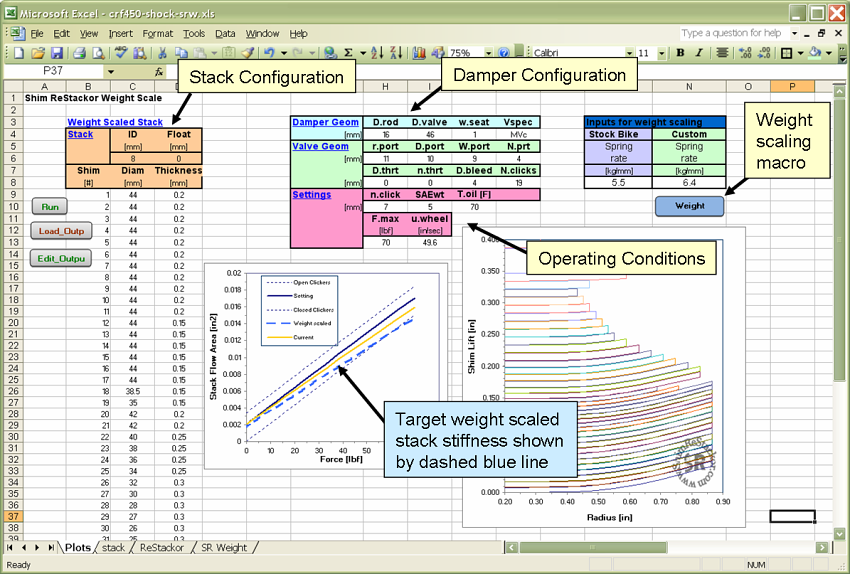

Tuning Basics
Sample Applications

ReStackor Sample Applications
Finally computer software to tune a shim stack
Retuning a stock suspension for a change in rider weight
Manufactures spend millions developing suspension designs for the simple purpose of winning the next MX bike shootout in the mags. The competition has evolved increasingly more sophisticated suspensions which are increasingly more focused on the specific weight and spring rate of the stock setup. If you can sit on a stock bike and get the right race sag you are set. If you have to change springs than the damping rates are off and you are not going to get the suspension performance the magazines rave about for you bike.
Spring-mass-damper theory defines the relationship between spring rate, rider weight, damping force and suspension response. The relationships define the damping modifications needed to correct for a spring rate change and maintain the suspension response, feel and performance the manufacture intended for your bike. The ReStackor-weight.xls spreadsheet makes application of this theory simple:
-
Enter the shock shim stack and spring rate to compute the damping performance of the stock suspension.
-
Enter the spring rate you want to use. Hit the weight scale button and the spreadsheet computes the damping force needed for the new spring rate. The dashed line shows the target damping force profile.
-
Adjust the stock shim stack to match the target damping force.
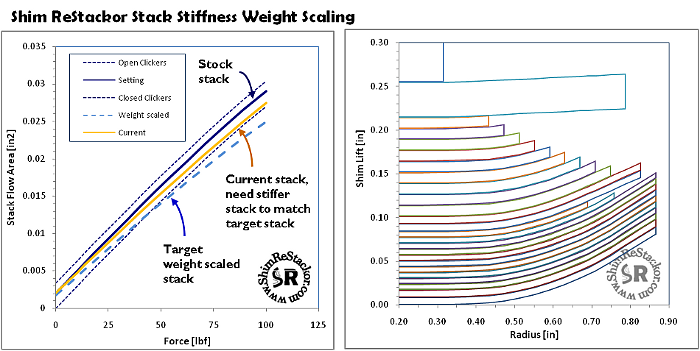
Weight scaling damping performance is easy with ReStackor. All you need to do is add or remove shims to match the stiffness of the target stack.
![]()
Weight Scaling a crf450 Shock Compression Shim Stack
The ReStackor-weight.xls spreadsheet has been specifically setup for weight scaling shim stacks. All you need to do is enter the stock shim stack, the stock spring rate and custom spring rate you want to use. Click the "Run" and "Weight" scale macro buttons and the spreadsheet will plot the stiffness of the target shim stack you need. From there all you need to do is tune the stack by adding or removing shims to match the target stack.
ReStackor spreadsheet for weight scaling a suspension setup
crf450 Shock Rebound Weight Scaling Example
The first step is to compute the stiffness of the stock shim stack. To do that you need the stock shim stack configuration and the geometry of the shock rebound valve port. For the example below the shock rebound stack is being weight scaled from the stock spring rate of 5.5 to a custom rate of 6.4 kg/mm.
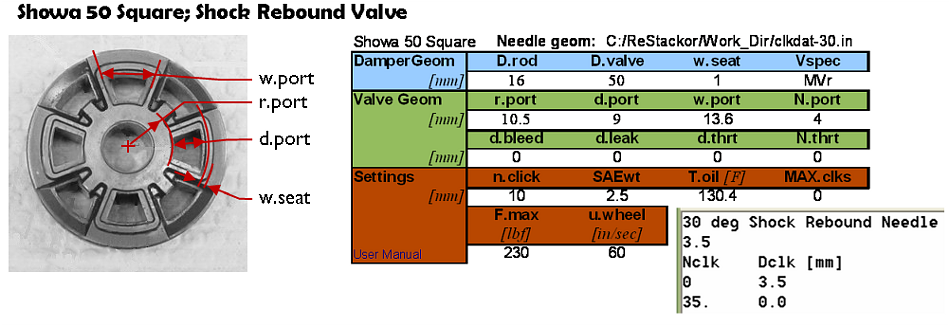
'06 crf450 shock rebound valve port geometry from Valving Logic
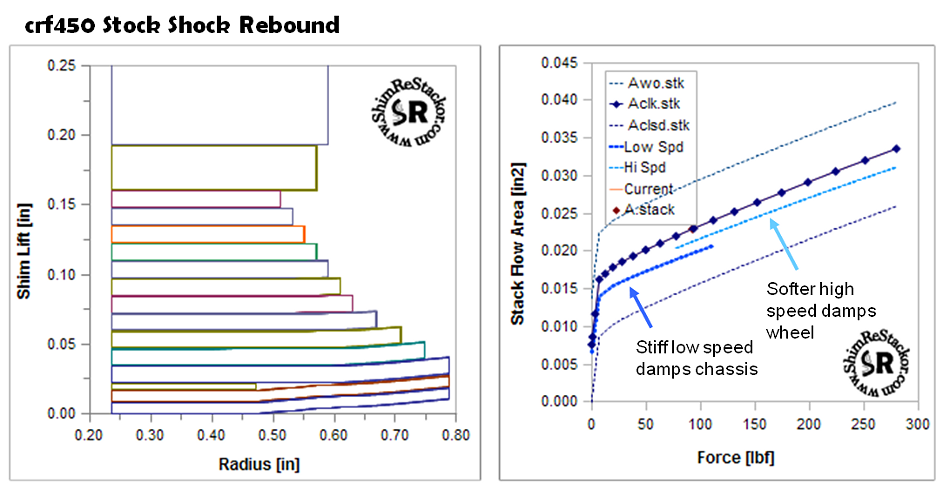
The ReStackor weight scaling spreadsheet shows you the shim stack stiffness needed to correct the stock damping rates for a spring rate change.
One thing that makes the art of suspension tuning difficult is the shock absorber is required to simultaneously accomplish two tasks. The shock has to be stiff enough to keep chassis from baby buggying and light enough to allow the wheel to instantaneously respond to bumps. Obviously, the shock can not be simultaneously soft and stiff so a compromise is needed. That compromise revolves around the idea of stiff low speed damping to control the chassis baby buggying and light high speed damping to allow rapid wheel motions. Optimum G has a whole series of technical articles discussing the engineering hand wringing that goes into the decision of where the shock absorber should transition from low to high speed damping.
For weight scaling a suspension that decision is much easier. The test rider team at the manufacture has already worked out the optimum split between low and high speed damping and the transition velocity that gives the best ride performance for the bike. All that needs to be done is scale the curve up or down to correct for the spring rate change while maintaining the same shape as the stock damping force curve.
Add Face Shims To Stiffen The Stack
The simplest approach to changing the shim stack stiffness is to simply add or remove shims from the face of the stack. For the example here adding eight face shims gets the stiffness into the ball park of the target damping force curve.
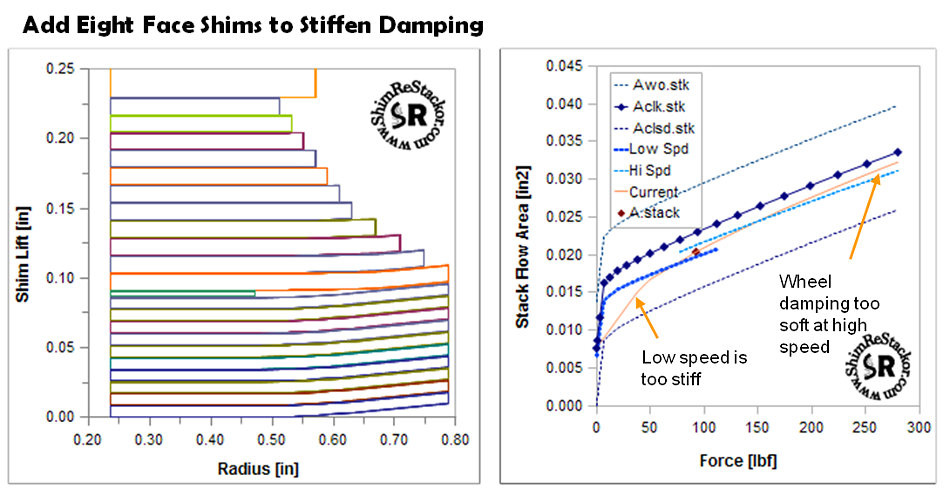
Adding face shims increases damping but does not give the damping profile shape needed.
By adding or removing face shims is about as far as the average seat of the pants tuner gets. With ReStackor calculations you can see the shape of the stack stiffness profile is not quite right. The low speed damping is too stiff and the high speed damping becomes a little too light at the top of the curve. Those differences are what the manufactures test rider team spent months trying to get right. To recover the ride, feel and performance of the original setup some more stack tuning is needed to get the shape right.
![]()
Clamp Shim Tuning
One approach to changing the shape of the curve is to change the diameter of the clamp shim at the top of the stack. For the example below the stock 26.3 clamp was changed to a 24.3 clamp. With the clamp change the number of face shims needs to be adjusted to keep the stack stiffness in the range of the target stack.
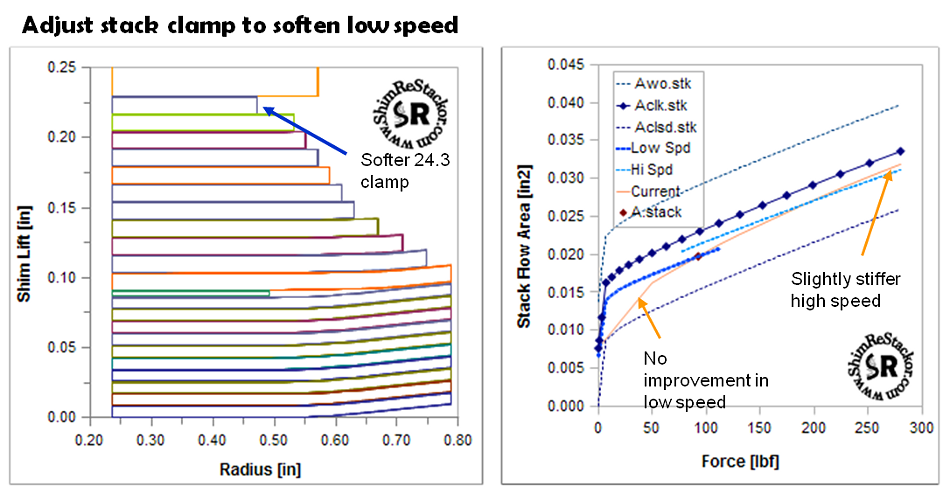
Changing the clamp shim diameter alters the shape of the shim stack stiffness profile.
For this stack the tapered section is really stiff and changes to the stack clamp diameter make little difference in the shape of the stiffness profile. To get the shape right additional modifications to the stack are needed.
![]()
Stack Taper Changes
Another approach is changing the stiffness of the tapered section. For the stack here shortening the tapered section increases the high speed stiffness. That gets the slope right at the top end.

Tuning the stack taper adjust the high speed stiffness of the shim stack.
Modifying the taper gets the high speed right but the low speed damping is still too stiff. Reducing the low speed damping is going to require some modifications to the crossover configuration.
![]()
Crossover Tuning
For tuning of a crossover gap you have a lot of options for controlling the shape of the stack stiffness profile:
-
Changing the diameter of the crossover alters the stiffness of the face shims
-
Changing the thickness alters force required to close the gap
-
Changing the position of the crossover alters the stack stiffness before and after the gap closes
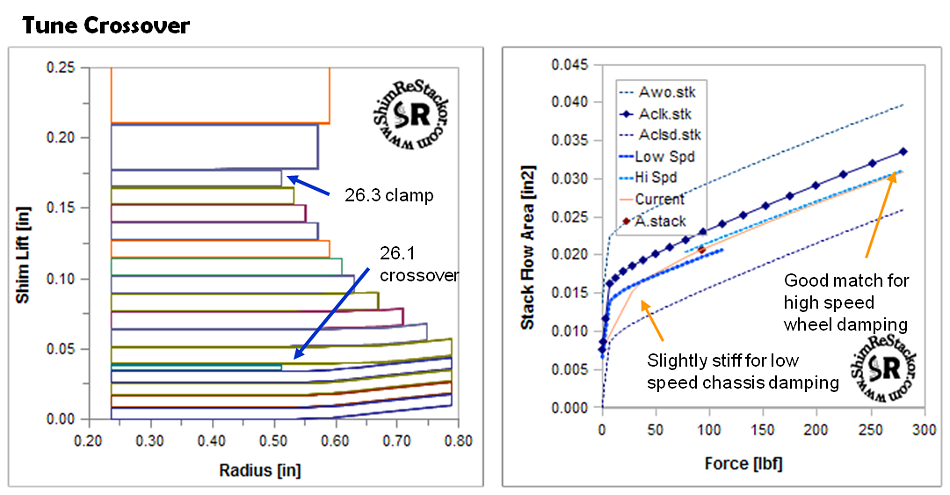
Changing the crossover gap alters the shape of the low speed stack stiffness profile
Changing the crossover shim diameter, stack clamp diameter and the number of face shims brings the stack pretty close to the stiffness profile of the target weight scaled stack. The stack is still a little too stiff at low speed. That change in low speed damping may cause the suspension to pack on successive bumps. Further refining of the stack is going to require moving the crossover down a shim or two to loosen up the low speed. The curve is pretty close and needs a test ride along with some clicker tuning to see if the low speed is going to pack or not.
To correct for a spring rate change simply adding or removing face shims only partially corrects the damping. Manufactures spend millions working with teams of test riders trying to perfect the shape of the damping profile. Maintaining that shape requires more than just adding or removing a couple of shims off of the face of the stack.
![]()
The "Butt" Dyno
In the end, suspensions are tested on the "butt dyno" and they either work or they don't. The problem in trying to use nothing more than seat-of-the-pants test rides to tune a suspension is every time you change the stack clamp diameter, stack taper or crossover you are looking a months of effort R&R'ing the shock trying to figure out how many face shims to add or subtract to get the stack back in the ball park of where you were.
ReStackor makes that process much easier. Weight scaling a stock stack will get you in the ball park of a workable setup right out of the box. Manufactures have spent millions working out the details of the shape of the stock damping force profile. Weight scaling that profile to the spring rates you are using will give you a solid starting point. From there, the stack can be fine tuned adjusting the stack clamp, taper and crossover to fine tune the damping profile based on the results of test rides.
ReStackor Features
-
See the shape of the stock damping force profile.
-
Weight scale the stock setup to the spring rate you are using.
-
Change the stack clamp, taper and crossover to fine tune the shape of the damping force profile.
-
Correct for simultaneous changes, like stack clamp and taper, to keep the damping force curve where you want it.
The capability to see the shape of the damping force profile and the effects of shim stack modifications on the shape of the damping force profile gives you the capability to find tune you suspension far beyond the limits previously possible. ReStackor defines a new era in suspension tuning.

